Evaluation of Mortality and Hospitalization Due to Decompensated Heart Failure and Appropriate Shocks in Reduced Ejection Fraction in Patients with an Implantable Cardioverter–Defibrillator According to a Novel Tissue Doppler Echocardiographic Method
Abstract
1. Introduction
2. Materials and Methods
2.1. Study Patients, and Design
2.2. Echocardiography
2.3. Data Collection
2.4. Study Endpoints
2.5. Statistical Analysis
3. Results
3.1. Patients Characteristics
3.2. Prognostic Impact of IVCDi × ST/SM in HFrEF Patients with ICD
3.3. Survival Analysis
3.4. Evaluation of Interobserver Agreement
4. Discussion
5. Conclusions
Author Contributions
Funding
Institutional Review Board Statement
Informed Consent Statement
Data Availability Statement
Conflicts of Interest
References
- Meyer, S.; Brouwers, F.P.; Voors, A.A.; Hillege, H.L.; de Boer, R.A.; Gansevoort, R.T.; van der Harst, P.; Rienstra, M.; van Gelder, I.C.; van Veldhuisen, D.J.; et al. Sex differences in new-onset heart failure. Clin. Res. Cardiol. 2015, 104, 342350. [Google Scholar] [CrossRef]
- GBD 2017 Disease and Injury Incidence and Prevalence Collaborators. Global, regional, and national incidence, prevalence, and years lived with disability for 354 diseases and injuries for 195 countries and territories, 1990–2017: A systematic analysis for the Global Burden of Disease Study 2017. Lancet 2018, 392, 17891858. [Google Scholar]
- Van Riet, E.E.; Hoes, A.W.; Limburg, A.; Landman, M.A.; van der Hoeven, H.; Rutten, F.H. Prevalence of unrecognized heart failure in older persons with shortness of breath on exertion. Eur. J. Heart Fail. 2014, 16, 772777. [Google Scholar] [CrossRef] [PubMed]
- Tsao, C.W.; Lyass, A.; Enserro, D.; Larson, M.G.; Ho, J.E.; Kizer, J.R.; Gottdiener, J.S.; Psaty, B.M.; Vasan, R.S. Temporal trends in the incidence of and mortality associated with heart failure with preserved and reduced ejection fraction. JACC Heart Fail. 2018, 6, 678685. [Google Scholar] [CrossRef] [PubMed]
- Braunwald, E.; Zipes, D.P.; Libby, P. Heart Disease, 6th ed.; Saunders Company: Philadelphia, PA, USA, 2001; pp. 348–439. [Google Scholar]
- Yock, P.G.; Popp, R.L. Noninvasive estimation of right ventricular systolic pressure by Doppler ultrasound in patients with tricuspid regurgitation. Circulation 1984, 70, 657–662. [Google Scholar] [CrossRef]
- Temporelli, P.L.; Giannuzzi, P.; Nicolosi, G.L.; Latini, R.; Franzosi, M.G.; Gentile, F.; Tavazzi, L.; Maggioni, A.P. Doppler-derived mitral deceleration time as a strong prognostic marker of left ventricular remodeling and survival after acute myocardial infarction: Results of the GISSI-3 echo substudy. J. Am. Coll. Cardiol. 2004, 43, 1646–1653. [Google Scholar] [CrossRef]
- Nishimura, R.A.; Tajik, A.J. Evaluation of diastolic filling of left ventricle in health and disease: Doppler echocardiography is the clinician’s Rosetta Stone. J. Am. Coll. Cardiol. 1997, 30, 8–18. [Google Scholar] [CrossRef]
- Nagueh, S.F.; Middleton, K.J.; Kopelen, H.A.; Zoghbi, W.A.; Quinones, M.A. Doppler tissue imaging: A noninvasive technique for evaluation of left ventricular relaxation and estimation of filling pressures. J. Am. Coll. Cardiol. 1997, 30, 1527–1533. [Google Scholar] [CrossRef]
- Ommen, S.R.; Nishimura, R.A.; Appleton, C.P.; Miller, F.A.; Oh, J.K.; Redfield, M.M.; Tajik, A.J. Clinical utility of Doppler echocardiography and tissue Doppler imaging in the estimation of left ventricular filling pressures: A comparative simultaneous Doppler-catheterization study. Circulation 2000, 102, 1788–1794. [Google Scholar] [CrossRef]
- Nagueh, S.F.; Mikati, I.; Kopelen, H.A.; Middleton, K.J.; Quinones, M.A.; Zoghbi, W.A. Doppler estimation of left ventricular filling pressure in sinus tachycardia. a new application of tissue doppler imaging. Circulation 1998, 98, 1644–1650. [Google Scholar] [CrossRef]
- Geske, J.B.; Sorajja, P.; Nishimura, R.A.; Ommen, S.R. Evaluation of left ventricular filling pressures by Doppler echocardiography in patients with hypertrophic cardiomyopathy: Correlation with direct left atrial pressure measurement at cardiac catheterization. Circulation 2007, 116, 2702–2708. [Google Scholar] [CrossRef] [PubMed]
- Santos, M.; Rivero, J.; McCullough, S.D.; West, E.; Opotowsky, A.R.; Waxman, A.B.; Systrom, D.M.; Shah, A.M. E/e’ ratio in patients with unexplained Dyspnea: Lack of accuracy in estimating left ventricular filling pressure. Circ. Heart Fail. 2015, 8, 749–756. [Google Scholar] [CrossRef]
- Chinen, D.; Nagai, T.; Uemura, K.; Aikawa, Y.; Motokawa, T.; Asaumi, Y.; Ogo, T.; Kanzaki, H.; Noguchi, T.; Anzai, T.; et al. Clinical Usefulness of an Echo-Doppler Model in Predicting Elevated Pulmonary Capillary Wedge Pressure in Patients With Heart Failure. Am. J. Cardiol. 2019, 123, 1464–1469. [Google Scholar] [CrossRef]
- Lang, R.M.; Bierig, M.; Devereux, R.B.; Flachskampf, F.A.; Foster, E.; Pellikka, P.A.; Picard, M.H.; Roman, M.J.; Seward, J.; Shanewise, J.S.; et al. Recommendations for chamber quantification: A report from the American Society of Echocardiography’s Guidelines and Standards Committee and the Chamber Quantification Writing Group, developed in conjunction with the European Association of Echocardiography, a branch of the European Society of Cardiology. J. Am. Soc. Echocardiogr. 2005, 18, 1440–1463. [Google Scholar]
- Zoghbi, W.A.; Enriquez-Sarano, M.; Foster, E.; Grayburn, P.A.; Kraft, C.D.; Levine, R.A.; Nihoyannopoulos, P.; Otto, C.M.; Quinones, M.A.; Rakowski, H.; et al. Recommendations for evaluation of the severity of native valvular regurgitation with twodimensional and Doppler echocardiography. J. Am. Soc. Echocardiogr. 2003, 16, 777–802. [Google Scholar] [CrossRef] [PubMed]
- Biais, M.; Carrié, C.; Delaunay, F.; Morel, N.; Revel, P.; Janvier, G. Evaluation of a new pocket echoscopic device for focused cardiac ultrasonography in an emergency setting. Crit. Care 2012, 16, R82. [Google Scholar] [CrossRef]
- Sim, J.; Wright, C.C. The kappa statistic in reliability studies: Use, interpretation, and sample size requirements. Phys. Ther. 2005, 85, 257–268. [Google Scholar] [CrossRef] [PubMed]
- Gheorghiade, M.; Follath, F.; Ponikowski, P.; Barsuk, J.H.; Blair, J.E.; Cleland, J.G.; Dickstein, K.; Drazner, M.H.; Fonarow, G.C.; Jaarsma, T.; et al. Assessing and grading congestion in acute heart failure: A scientific statement from the Acute Heart Failure Committee of the Heart Failure Association of the European Society of Cardiology and endorsed by the European Society of Intensive Care Medicine. Eur. J. Heart Fail. 2010, 12, 423–433. [Google Scholar] [CrossRef]
- McMurray, J.J.; Adamopoulos, S.; Anker, S.D.; Auricchio, A.; Böhm, M.; Dickstein, K.; Falk, V.; Filippatos, G.; Fonseca, C.; Gomez-Sanchez, M.A.; et al. ESC guidelines for the diagnosis and treatment of acute and chronic heart failure 2012: The Task Force for the Diagnosis and Treatment of Acute and Chronic Heart Failure 2012 of the European Society of Cardiology. Developed in collaboration with the Heart Failure Association (HFA) of the ESC. Eur. J. Heart Fail. 2012, 14, 803–869. [Google Scholar]
- Ambrosy, A.P.; Pang, P.S.; Khan, S.; Konstam, M.A.; Fonarow, G.C.; Traver, B.; Maggioni, A.P.; Cook, T.; Swedberg, K.; Burnett JCJr Grinfeld, L.; et al. Clinical course and predictive value of congestion during hospitalization in patients admitted for worsening signs and symptoms of heart failure with reduced ejection fraction: Findings from the EVEREST trial. Eur. Heart J. 2013, 34, 835–843. [Google Scholar] [CrossRef]
- Dash, H.; Lipton, M.J.; Chatterjee, K.; Parmley, W.W. Estimation of pulmonary artery wedge pressure from chest radiograph in patients with chronic congestive cardiomyopathy and ischaemic cardiomyopathy. Br. Heart J. 1980, 44, 322–329. [Google Scholar] [CrossRef] [PubMed]
- Nagueh, S.F.; Smiseth, O.A.; Appleton, C.P.; Byrd, B.F., 3rd; Dokainish, H.; Edvardsen, T.; Flachskampf, F.A.; Gillebert, T.C.; Klein, A.L.; Lancellotti, P.; et al. Recommendations for the Evaluation of Left Ventricular Diastolic Function by Echocardiography: An Update from the American Society of Echocardiography and the European Association of Cardiovascular Imaging. J. Am. Soc. Echocardiogr. 2016, 29, 277–314. [Google Scholar] [CrossRef]
- Jones, R.; Varian, F.; Alabed, S.; Morris, P.; Rothman, A.; Swift, A.J.; Lewis, N.; Kyriacou, A.; Wild, J.M.; Al-Mohammad, A.; et al. Meta-analysis of echocardiographic quantification of left ventricular filling pressure. ESC Heart Fail. 2021, 8, 566–576. [Google Scholar] [CrossRef] [PubMed]
- Nauta, J.F.; Hummel, Y.M.; van der Meer, P.; Lam, C.S.P.; Voors, A.A.; van Melle, J.P. Correlation with invasive left ventricular filling pressures and prognostic relevance of the echocardiographic diastolic parameters used in the 2016 ESC heart failure guidelines and in the 2016 ASE/EACVI recommendations: A systematic review in patients with heart failure with preserved ejection fraction. Eur. J. Heart Fail. 2018, 20, 1303–1311. [Google Scholar] [PubMed]
- Aimo, A.; Pateras, K.; Stamatelopoulos, K.; Bayes-Genis, A.; Lombardi, C.M.; Passino, C.; Emdin, M.; Georgiopoulos, G. Relative efficacy of sacubitril-valsartan, vericiguat, and SGLT2 inhibitors in heart failure with reduced ejection fraction: A systematic review and network meta-analysis. Cardiovasc. Drugs Ther. 2021, 35, 1067–1076. [Google Scholar] [CrossRef]
- Pagnesi, M.; Baldetti, L.; Aimo, A.; Inciardi, R.M.; Tomasoni, D.; Vizzardi, E.; Vergaro, G.; Emdin, M.; Lombardi, C.M. Prognostic benefit of new drugs for HFrEF: A systematic review and network meta-analysis. J. Clin. Med. 2022, 11, 348. [Google Scholar] [CrossRef]
- McMurray, J.J.; Packer, M.; Desai, A.S.; Gong, J.; Lefkowitz, M.P.; Rizkala, A.R.; Rouleau, J.L.; Shi, V.C.; Solomon, S.D.; Swedberg, K.; et al. Angiotensin-neprilysin inhibition versus enalapril in heart failure. N. Engl. J. Med. 2014, 371, 993–1004. [Google Scholar] [CrossRef]
- McMurray, J.J.; Solomon, S.D.; Inzucchi, S.E.; Køber, L.; Kosiborod, M.N.; Martinez, F.A.; Ponikowski, P.; Sabatine, M.S.; Anand, I.S.; Bělohlávek, J.; et al. Dapagliflozin in patients with heart failure and reduced ejection fraction. N. Engl. J. Med. 2019, 381, 1995–2008. [Google Scholar] [CrossRef]
- Packer, M.; Anker, S.D.; Butler, J.; Filippatos, G.; Pocock, S.J.; Carson, P.; Januzzi, J.; Verma, S.; Tsutsui, H.; Brueckmann, M.; et al. Cardiovascular and renal outcomes with empagliflozin in heart failure. N. Engl. J. Med. 2020, 383, 1413–1424. [Google Scholar] [CrossRef]
- Armstrong, P.W.; Pieske, B.; Anstrom, K.J.; Ezekowitz, J.; Hernandez, A.F.; Butler, J.; Lam, C.S.; Ponikowski, P.; Voors, A.A.; Jia, G.; et al. Vericiguat in patients with heart failure and reduced ejection fraction. N. Engl. J. Med. 2020, 382, 1883–1893. [Google Scholar] [CrossRef]
- Teerlink, J.R.; Diaz, R.; Felker, G.M.; McMurray, J.J.; Metra, M.; Solomon, S.D.; Adams, K.F.; Anand, I.; Arias-Mendoza, A.; Biering-Sørensen, T.; et al. Cardiac myosin activation with omecamtiv mecarbil in systolic heart failure. N. Engl. J. Med. 2021, 384, 105–116. [Google Scholar] [CrossRef] [PubMed]
- Lavalle, C.; Mariani, M.V.; Severino, P.; Palombi, M.; Trivigno, S.; D’Amato, A.; Silvetti, G.; Pierucci, N.; Di Lullo, L.; Chimenti, C.; et al. Efficacy of Modern Therapies for Heart Failure with Reduced Ejection Fraction in Specific Population Subgroups: A Systematic Review and Network Meta-Analysis. Cardiorenal Med. 2024, 14, 570–580. [Google Scholar] [CrossRef] [PubMed]
- Bassi, N.S.; Ziaeian, B.; Yancy, C.W.; Fonarow, G.C. Association of Optimal Implementation of Sodium-Glucose Cotransporter 2 Inhibitor Therapy With Outcome for Patients With Heart Failure. JAMA Cardiol. 2020, 5, 948–951. [Google Scholar] [CrossRef] [PubMed]
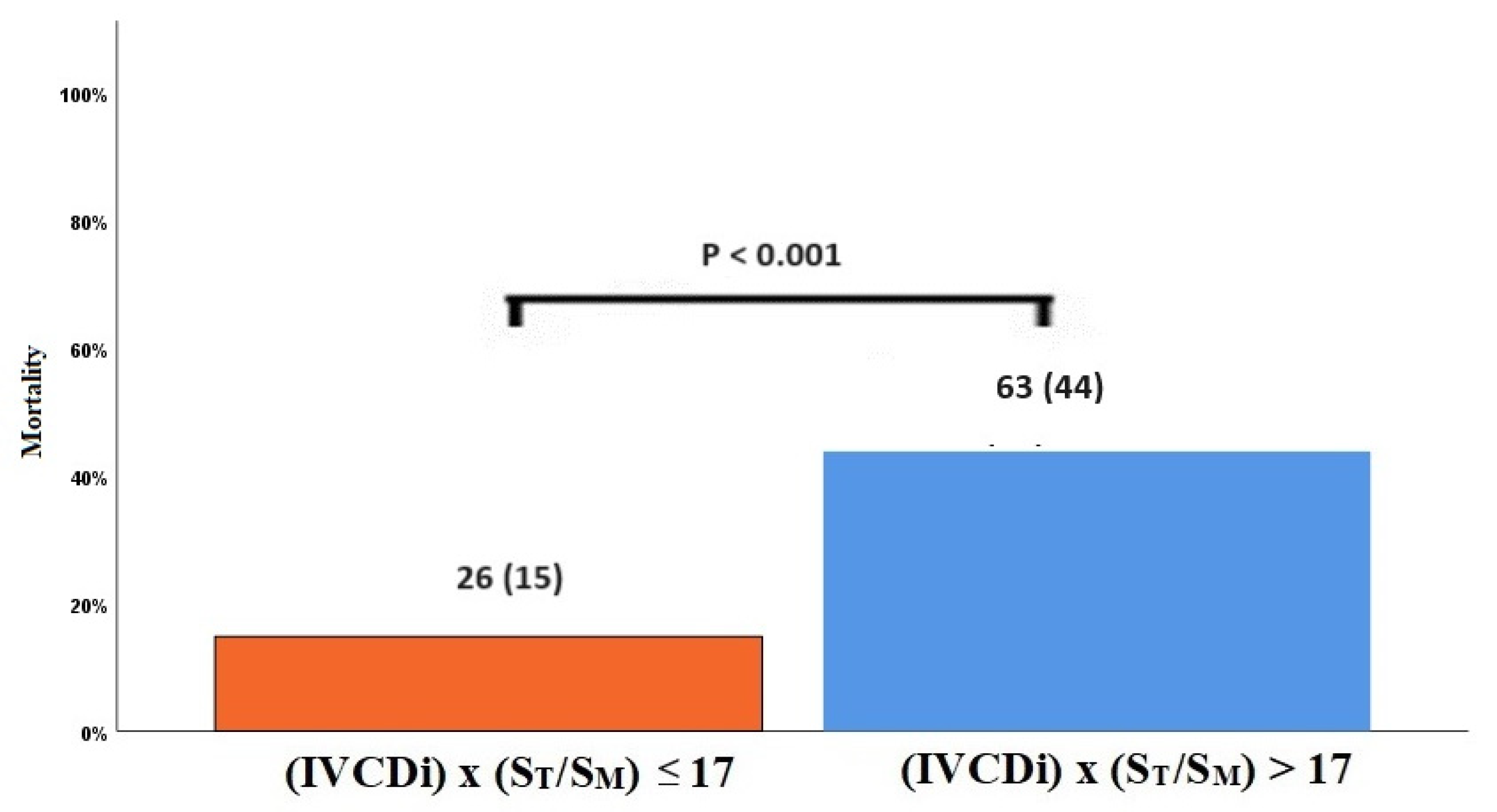
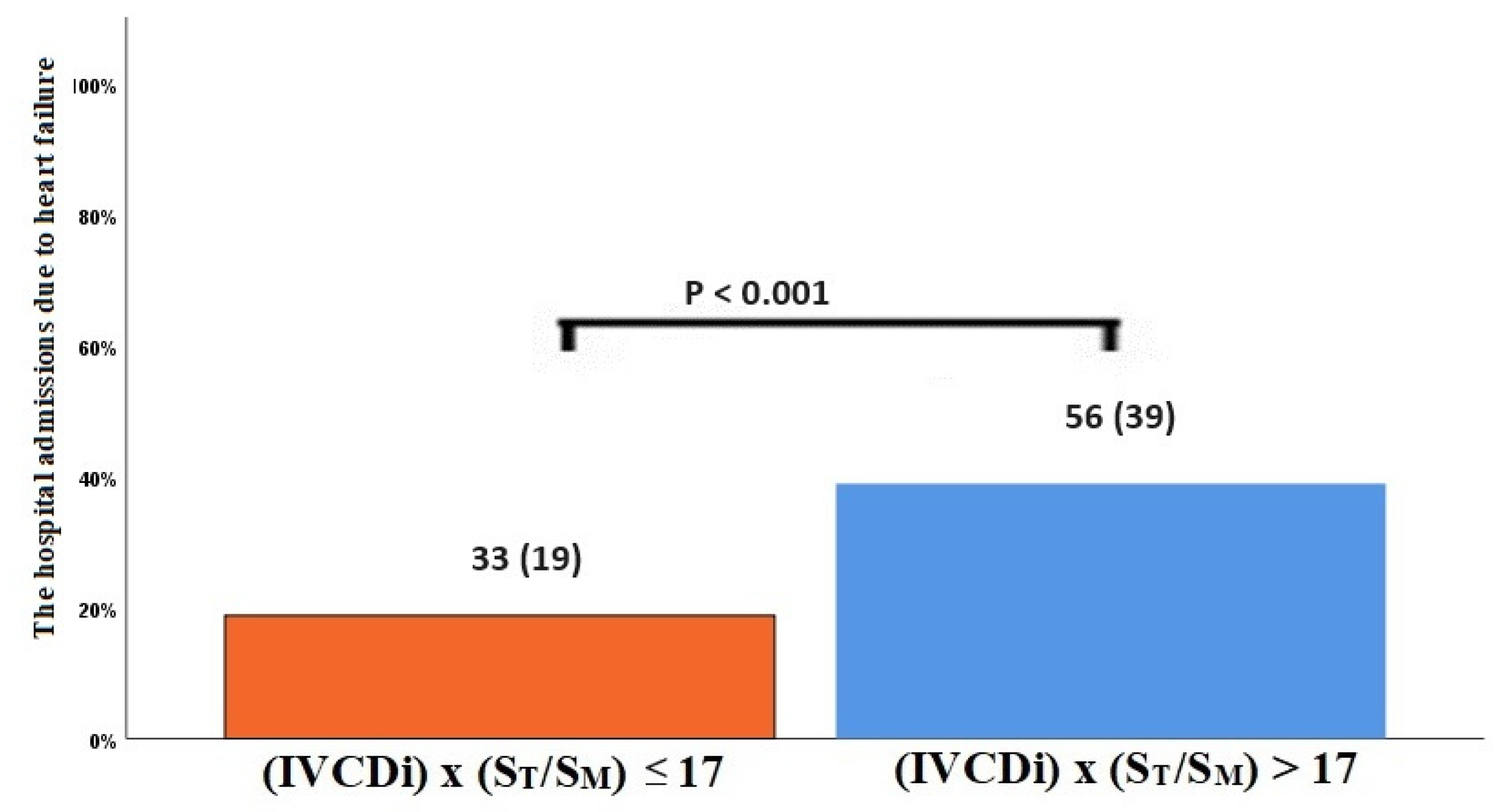
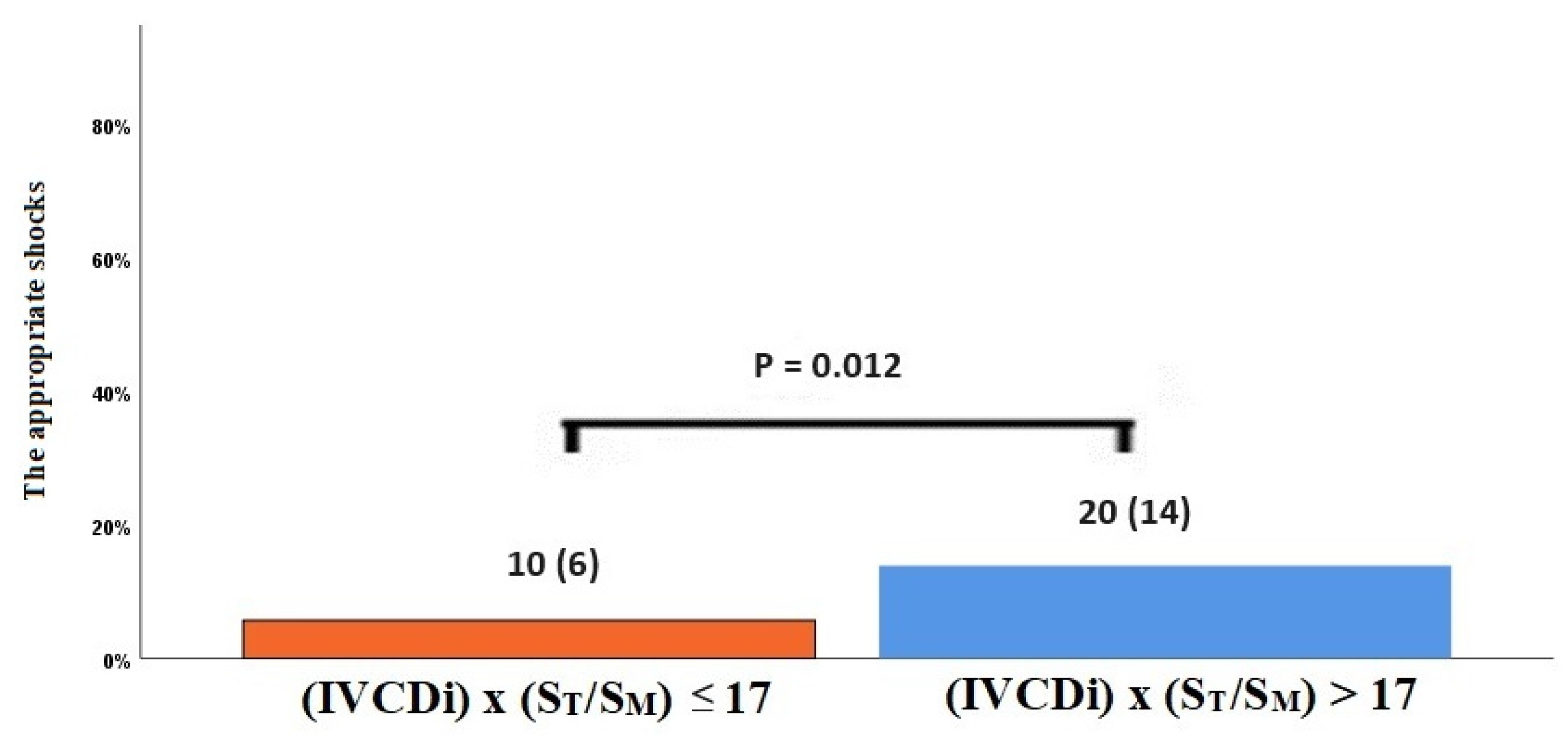
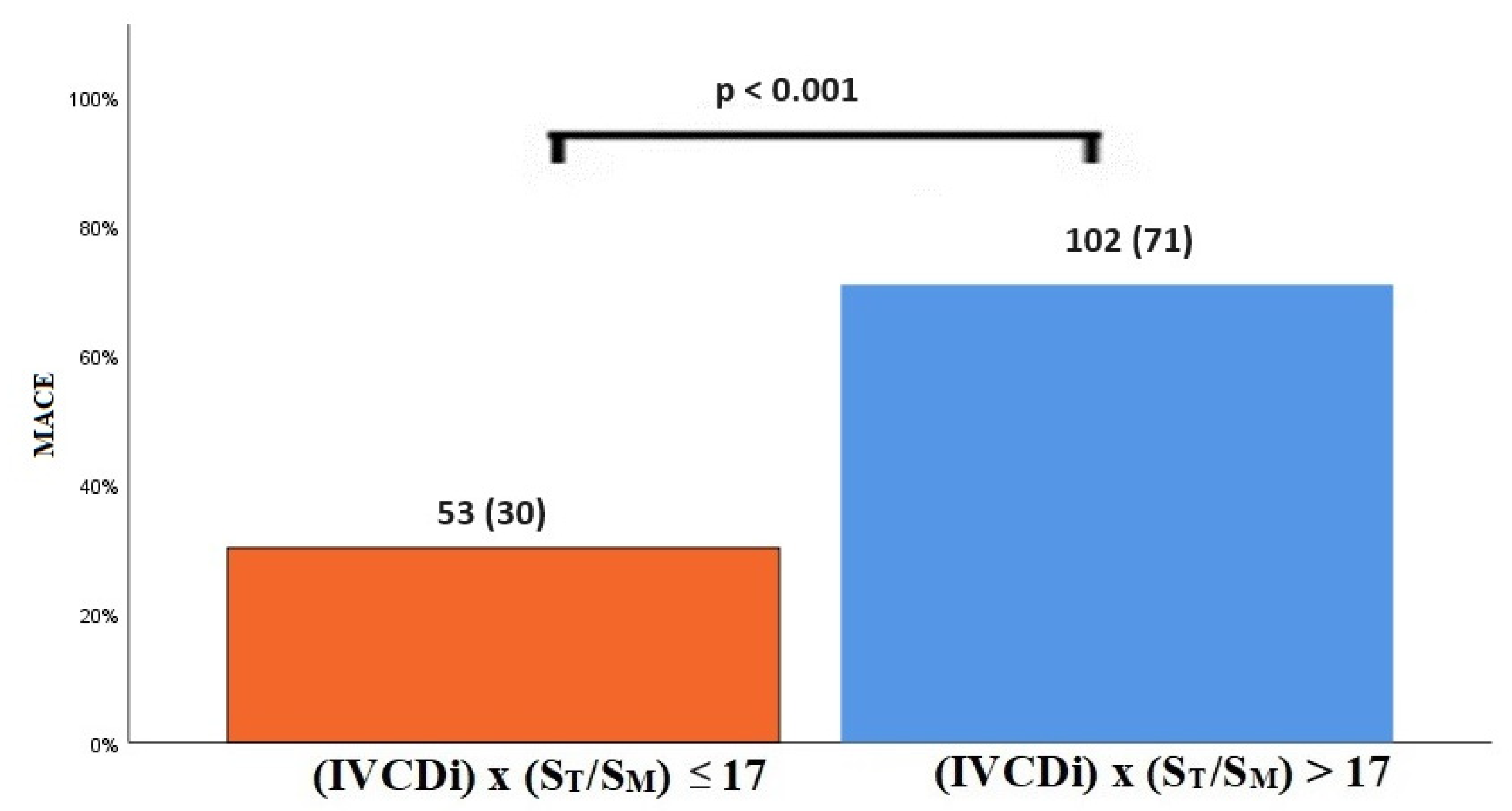
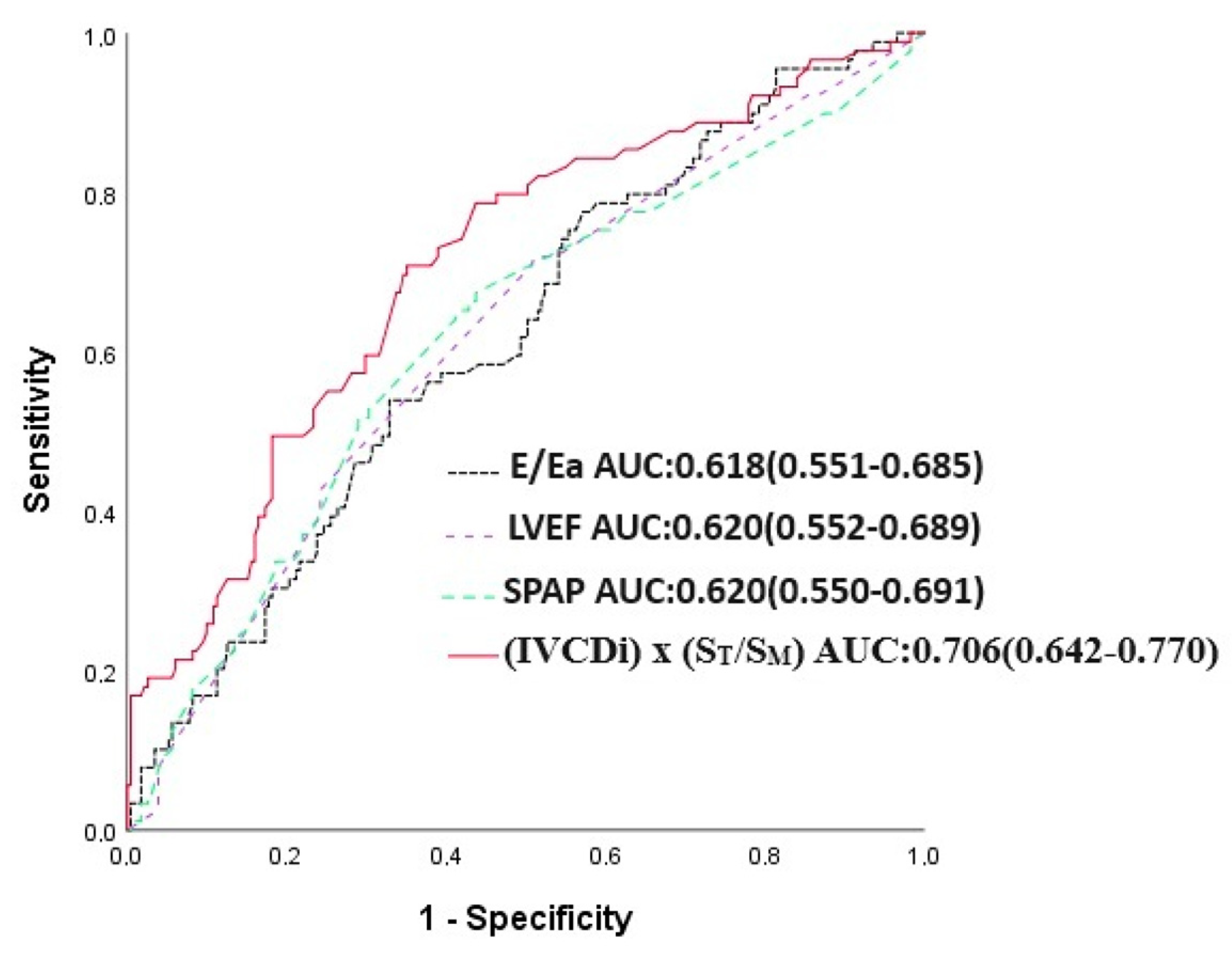

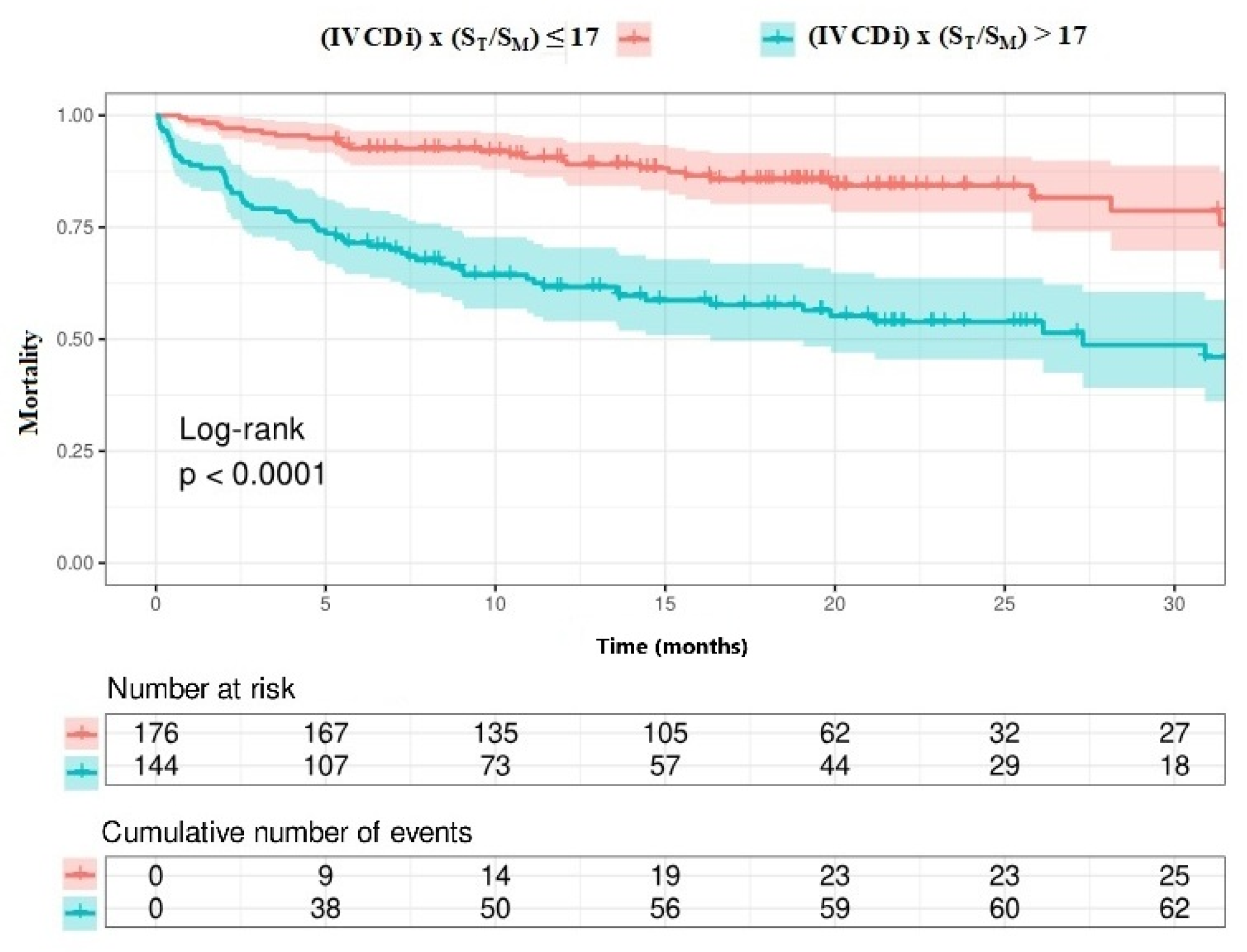
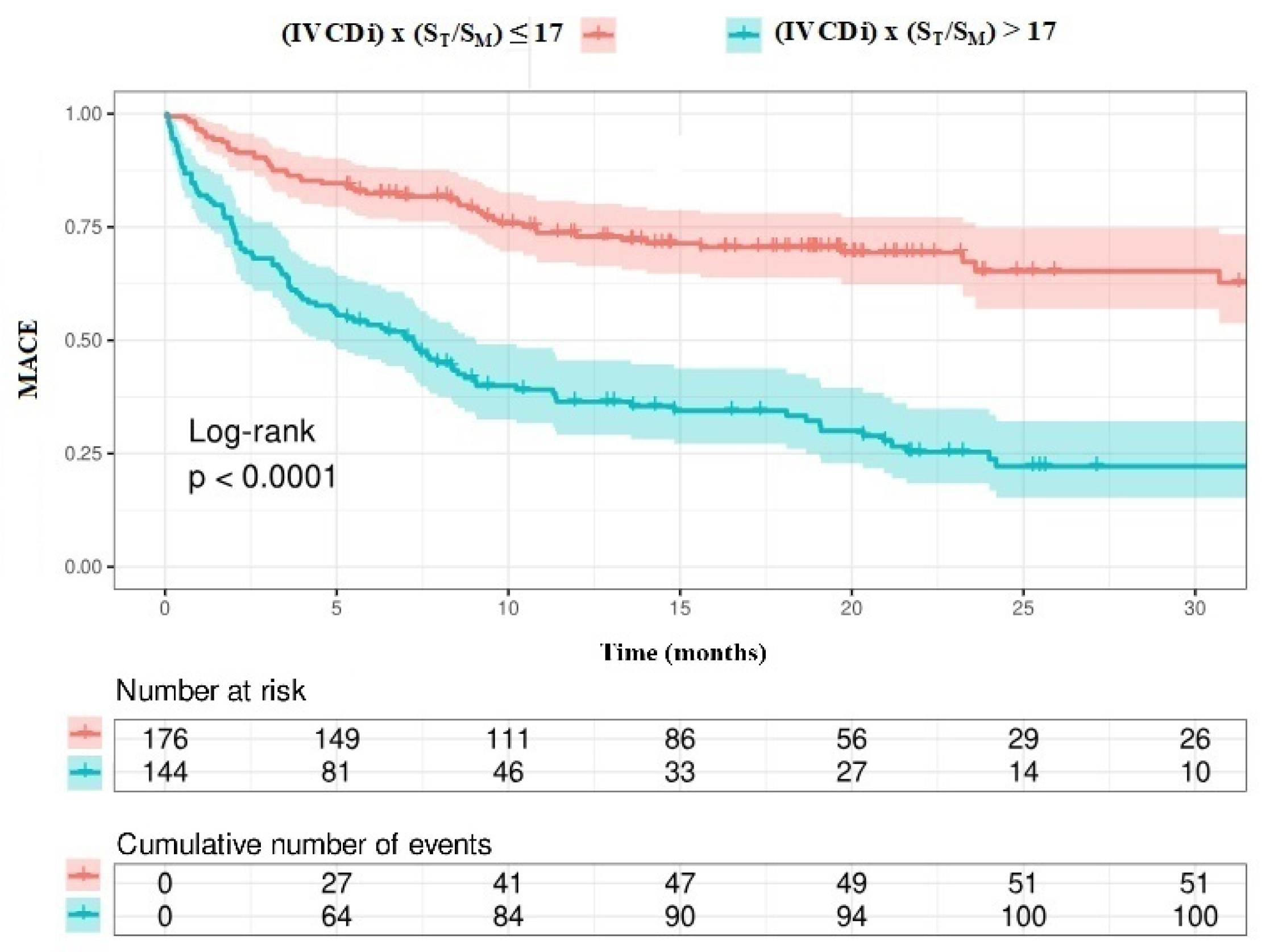
| Variables | (IVCDi) × (ST/SM) ≤ 17 (n = 176) | (IVCDi) × (ST/SM) > 17 (n = 144) | p-Value |
|---|---|---|---|
| Age, years | 62.3 ± 10.5 | 62.5 ± 12.0 | 0.911 |
| Female gender (%) | 28 (16) | 20 (14) | 0.615 |
| Hypertension, n (%) | 94 (53) | 73 (51) | 0.629 |
| Diabetes mellitus, n (%). | 66 (38) | 61 (42) | 0.377 |
| Previous CKD, n (%) | 25 (14) | 44 (31) | <0.001 |
| Atrial fibrillation, n (%) | 24 (14) | 42 (29) | 0.001 |
| Asthma or COPD, n (%) | 27 (15) | 15 (10) | 0.194 |
| Previous CAD, n (%) | 129 (73) | 99 (69) | 0.371 |
| Previous stroke/TIA, n (%) | 18 (10) | 15 (10) | 0.956 |
| NYHA ≥ III, n (%) | 26 (15) | 56 (39) | <0.001 |
| Ischemic cardiomyopathy, n (%) | 128 (73) | 99 (69) | 0.428 |
| CRT, n (%) | 30 (17) | 21 (15) | 0.549 |
| Medical treatment, n (%) | |||
| B-blockers | 169 (96) | 133 (92) | 0.157 |
| ACEi/ARB | 126 (72) | 92 (64) | 0.141 |
| MRA | 132 (75) | 89 (62) | 0.011 |
| Loop diüretics | 124 (71) | 119 (83) | 0.011 |
| Digitalis | 6 (3) | 13 (9) | 0.034 |
| İvabradine | 26 (15) | 23 (16) | 0.767 |
| Amiodarone | 22 (13) | 39 (28) | 0.001 |
| SGLT-2 inhibitors | 30 (17) | 28 (19) | 0.579 |
| ARNI | 9 (5) | 11 (8) | 0.353 |
| Variables | (IVCDi) × (ST/SM) ≤ 17 (n = 176) | (IVCDi) × (ST/SM) > 17 (n = 144) | p-Value |
|---|---|---|---|
| BNP (ng/L) | 375 (144.5–833.5) | 1378 (538–3380) | <0.001 |
| LVEF (%) | 27.6 ± 5.0 | 24.3 ± 5.3 | <0.001 |
| E velocity, cm/s | 85.0 ± 27.3 | 97.0 ± 23.3 | <0.001 |
| Ea velocity, cm/s | 7.9 ± 2.5 | 6.7 ± 2.3 | <0.001 |
| E/Ea | 11.6 ± 4.7 | 16.0 ± 6.5 | <0.001 |
| SM, cm/s | 5.2 ± 1.4 | 4.6 ± 1.3 | <0.001 |
| ST, cm/s | 9.4 ± 2.3 | 9.5 ± 3.0 | 0.688 |
| ST/SM | 1.9 ± 0.5 | 2.1 ± 0.7 | <0.001 |
| TAPSE, mm | 16.7 ± 3.3 | 15.0 ± 4.2 | 0.001 |
| IVCDi, mm | 6.6 ± 2.1 | 14.5 ± 6.0 | <0.001 |
| SPAB (mm Hg) | 31.7 ± 11.4 | 39.3 ± 11.9 | <0.001 |
| IVCDi × ST/SM, mm | 11.8 ± 3.3 | 28.8 ± 11.2 | <0.001 |
| Variables | r-Value | p-Value |
|---|---|---|
| SPAB (mm Hg) | 0.342 | <0.001 |
| E velocity, cm/s | 0.241 | <0.001 |
| Ea velocity, cm/s | −0.204 | <0.001 |
| E/Ea | 0.362 | <0.001 |
| LVEF(%) | −0.304 | <0.001 |
| TAPSE | −0.191 | <0.001 |
| BNP (ng/L) | 0.464 | <0.001 |
| NYHA sınıfı | 0.304 | <0.001 |
| Outcomes | (IVCDi) × (ST/SM) ≤ 17 (n = 176) | (IVCDi) × (ST/SM) > 17 (n = 144) | p Value |
|---|---|---|---|
| MACE, n (%) | 53 (30) | 102 (71) | <0.001 |
| Heart failure decompensation, n (%) | 33 (19) | 56 (39) | <0.001 |
| Appropriate shock occurrence, n (%) | 10 (6) | 20 (14) | 0.012 |
| Long-term mortality, n (%) | 26 (15) | 63 (44) | <0.001 |
| Univariate | Multivariate | |||||||||
|---|---|---|---|---|---|---|---|---|---|---|
| Model 1 | Model 2 | Model 3 | Model 4 | |||||||
| Variables | HR (95%CI) | p | HR (95%CI) | p | HR (95%CI) | p | HR (95%CI) | p | HR (95%CI) | p |
| Age (years) | 1.009 (1.030–1.052) | 0.005 | 1.012 (0.990–1.034) | 0.284 | 1.007 (0.986–1.029) | 0.526 | 1.007 (0.986–1.030) | 0.508 | 1.012 (0.989–1.035) | 0.313 |
| Previous CKD | 3.492 (2.284–5.341) | <0.001 | 1.955 (1.111–3.439) | 0.020 | 1.720 (0.989–2.991) | 0.055 | 1.731 (1.003–2.989) | 0.049 | 1.953 (1.118–3.412) | 0.019 |
| NYHA class | 3.314 (2.397–4.581) | <0.001 | 2.364 (1.647–3.392) | <0.001 | 2.580 (1.791.3715) | <0.001 | 2.529 (1.777–3.599) | <0.001 | 2.248 (1.553–3.245) | <0.001 |
| ACE-I/ARB usage | 0.404 (0.266–0.615) | <0.001 | 0.622 (0.387–1.001) | 0.050 | 0.607 (0.369–0.996) | 0.048 | 0.629 (0.388–1.017) | 0.059 | 0.644 (0.402–1.032) | 0.067 |
| Loop diuretıcs usage | 2.735 (1.452–5.152) | 0.002 | 1.679 (0.833–3.384) | 0.147 | 1.642 (0.809–3.332) | 0.170 | 1.677 (0.831–3.383) | 0.149 | 1.627 (0.799–3.315) | 0.180 |
| MRA usage | 0.664 (0.434–1.017) | 0.060 | 1.283 (0.754–2.182) | 0.359 | 1.231 (0.728–2.081) | 0.438 | 1.292 (0.763–2.187) | 0.341 | 1.437 (0.837–2.468) | 0.189 |
| BNP | 1.000 (1.000–1.000) | <0.001 | 1.000 (1.000–1.000) | 0.001 | 1.000 (1.000–1.000) | <0.001 | 1.000 (1.000–1.000) | <0.001 | 1.000 (1.000–1.000) | 0.003 |
| Appropriate shock | 1.783 (1.005–3.160) | 0.048 | 2.236 (1.212–4.125) | 0.010 | 2.116 (1.150–3.894) | 0.016 | 2.084 (1.127–3.856) | 0.019 | 1.901 (1.027–3.519) | 0.041 |
| Heart failure decompensation | 1.804 (1.180–2.157) | 0.006 | 1.221 (0.762–1.957) | 0.407 | 1.142 (0.716–1.820) | 0.577 | 1.188 (0.743–1.900) | 0.472 | 1.198 (0.755–1.899) | 0.443 |
| E/Ea | 1.043 (1.013–1.074) | 0.005 | 1.030 (0.998–1.063) | 0.069 | ||||||
| SPAP | 1.034 (1.021–1.047) | <0.001 | 1.013 (0.998–1.029) | 0.530 | ||||||
| LVEF | 0.936 (0.900–0.973) | 0.001 | 0.9541 (0.914–0.996) | 0.031 | ||||||
| TAPSE | 0.979 (0.042–1.016) | 0.266 | ||||||||
| (IVCDi) × (ST/SM) | 1.043 (1.030–1.057) | <0.001 | 1.027 (1.009–1.046) | 0.003 | ||||||
| Variables | HR 95%CI | p | HR 95%CI | p |
|---|---|---|---|---|
| Age (Years) | 1.009 (1.030–1.052) | 0.005 | ||
| Previous CKD | 3.492 (2.284–5.341) | <0.001 | 2.100 (1.171–3.766) | 0.013 |
| NYHA class | 3.314 (2.397–4.581) | <0.001 | 1.775 (1.234–2.554) | 0.002 |
| ACE-I/ARB usage | 0.404 (0.266–0.615) | <0.001 | ||
| Loop diuretıcs usage | 2.735 (1.452–5.152) | 0.002 | ||
| MRA usage | 0.664 (0.434–1.017) | 0.060 | ||
| BNP | 1.000 (1.000–1.000) | <0.001 | 1.000 (1.000–1.000) | <0.001 |
| Appropriate shock | 1.783 (1.005–3.160) | 0.048 | 2.159 (1.174–3.974) | 0.013 |
| Heart failure decompensation | 1.804 (1.180–2.157) | 0.006 | ||
| E/Ea | 1.043 (1.013–1.074) | 0.005 | ||
| SPAP | 1.034 (1.021–1.047) | <0.001 | ||
| LVEF | 0.936 (0.900–0.973) | 0.001 | 0.943 (0.902–0.985) | 0.008 |
| TAPSE | 0.979 (0.042–1.016) | 0.266 | ||
| (IVCDi) × (ST/SM) | 1.043 (1.030–1.057) | <0.001 | 1.34 (1.016–1.053) | <0.001 |
| Univariate | Multivariate | |||||||||
|---|---|---|---|---|---|---|---|---|---|---|
| Model 1 | Model 2 | Model 3 | Model 4 | |||||||
| Variables | HR (95%CI) | p | HR (95%CI) | p | HR (95%CI) | p | HR (95%CI) | p | HR (95%CI) | p |
| Age (years) | 1.019 (1.003–1.035) | 0.019 | 0.996 (0.980–1.013) | 0.654 | 0.991 (0.975–1.007) | 0.269 | 0.991 (0.975–1.008) | 0.298 | 0.9956 (0.978–1.011) | 0.525 |
| Male gender | 1.842 (1.081–3.139) | 0.025 | 1.634 (1.241–2.152) | <0.001 | 1.621 (1.230–2.135) | 0.001 | 2.655 (1.531–4.604) | 0.001 | 2.349 (1.346–4.099) | 0.003 |
| Previous CKD | 3.947 (2.820–5.527) | <0.001 | 3.048 (1.999–4.647) | <0.001 | 2.508 (1.673–3.759) | <0.001 | 2.458 (1.641–3.681) | <0.001 | 2.556 (1.072–3.840) | < 0.001 |
| NYHA | 2.629 (2.081–3.320) | <0.001 | 2.223 (1.700–2.909) | <0.001 | 2.387 (1.821–3.129) | <0.001 | 2.381 (1.829–3.100) | <0.001 | 2.165 (1.647–2.846) | <0.001 |
| ACE-I/ARB usage | 0.412 (0.299–0.568) | <0.001 | 0.559 (0.395–0.791) | 0.001 | 0.559 (0.393–0.795) | 0.001 | 0.560 (0.395–0.795) | 0.001 | 0.569 (0.403–0.806) | 0.001 |
| Loop diuretıcs usage | 2.061 (1.340–3.168) | 0.001 | 1.033 (0.644–1.655) | 0.893 | 1.180 (0.738–1.887) | 0.488 | 1.137 (0.714–1.811) | 0.587 | 1.108 (0.692–1.774) | 0.670 |
| MRA usage | 0.675 (0.487–0.935) | 0.018 | 1.285 (0.872–1.892) | 0.205 | 1.125 (0.779–1.627) | 0.529 | 1.253 (0.856–1.834) | 0.245 | 1.304 (0.883–1.926) | 0.182 |
| AF | 1.459 (1.012–2.106) | 0.043 | 1.128 (0.760–1.673) | 0.551 | 1.215 (0.830–1.779) | 0.403 | 1.161 (0.784–1.721) | 0.456 | 1.083 (0.725–1.617) | 0.237 |
| CRT | 0.601 (0.367–0.983) | 0.043 | 0.769 (0.461–1.282) | 0.314 | 0.774 (0.465–1.289) | 0.325 | 0.716 (0.427–1.200) | 0.205 | 0.734 (0.440–1.225) | 0.237 |
| BNP | 1.000 (1.000–1.000) | <0.001 | 1.000 (1.000–1.000) | 0.173 | 1.000 (1.000–1.000) | 0.024 | 1.000 (1.000–1.000) | 0.020 | 1.000 (1.000–1.000) | 0.208 |
| E/Ea | 1.045 (1.021–1.070) | <0.001 | 1.033 (1.007–1.059) | 0.011 | ||||||
| SPAP | 1.032 (1.023–1.042) | <0.001 | 1.000 (0.987–1.013) | 0.996 | ||||||
| LVEF | 0.932 (0.905–0.961) | <0.001 | 0.942 (0.912–0.973) | <0.001 | ||||||
| TAPSE | 0.997 (0.970–1.026) | 0.857 | ||||||||
| (IVCDi) × (ST/SM) | 1.039 (1.029–1.050) | <0.001 | 1.018 (1.004–1.032) | 0.013 | ||||||
| Variables | HR (95%CI) | p | HR (95%CI) | p |
|---|---|---|---|---|
| Age (years) | 1.019 (1.003–1.035) | 0.019 | ||
| Male gender | 1.842 (1.081–3.139) | 0.025 | 2.491 (1.418–4.383) | 0.002 |
| Previous CKD | 3.947 (2.820–5.527) | <0.001 | 3.111 (2.024–4.781) | <0.001 |
| NYHA | 2.629 (2.081–3.320) | <0.001 | 2.169 (1.648–2.854) | <0.001 |
| ACE-I/ARB usage | 0.412 (0.299–0.568) | <0.001 | 0.535 (0.377–0.760) | <0.001 |
| Loop diuretıcs usage | 2.061 (1.340–3.168) | 0.001 | ||
| MRA usage | 0.675 (0.487–0.935) | 0.018 | ||
| AF | 1.459 (1.012–2.106) | 0.043 | ||
| CRT | 0.601 (0.367–0.983) | 0.043 | ||
| BNP | 1.000 (1.000–1.000) | <0.001 | ||
| E/Ea | 1.045 (1.021–1.070) | <0.001 | ||
| SPAP | 1.032 (1.023–1.042) | <0.001 | ||
| LVEF | 0.932 (0.905–0.961) | <0.001 | 0.947 (0.916–0.978) | 0.001 |
| TAPSE | 0.997 (0.970–1.026) | 0.857 | ||
| (IVCDi) × (ST/SM) | 1.039 (1.029–1.050) | <0.001 | 1.017 (1.003–1.032) | 0.021 |
Disclaimer/Publisher’s Note: The statements, opinions and data contained in all publications are solely those of the individual author(s) and contributor(s) and not of MDPI and/or the editor(s). MDPI and/or the editor(s) disclaim responsibility for any injury to people or property resulting from any ideas, methods, instructions or products referred to in the content. |
© 2025 by the authors. Licensee MDPI, Basel, Switzerland. This article is an open access article distributed under the terms and conditions of the Creative Commons Attribution (CC BY) license (https://creativecommons.org/licenses/by/4.0/).
Share and Cite
Akkan, G.; Kiris, T.; Esin, F.; Karaca, M. Evaluation of Mortality and Hospitalization Due to Decompensated Heart Failure and Appropriate Shocks in Reduced Ejection Fraction in Patients with an Implantable Cardioverter–Defibrillator According to a Novel Tissue Doppler Echocardiographic Method. J. Clin. Med. 2025, 14, 3226. https://doi.org/10.3390/jcm14093226
Akkan G, Kiris T, Esin F, Karaca M. Evaluation of Mortality and Hospitalization Due to Decompensated Heart Failure and Appropriate Shocks in Reduced Ejection Fraction in Patients with an Implantable Cardioverter–Defibrillator According to a Novel Tissue Doppler Echocardiographic Method. Journal of Clinical Medicine. 2025; 14(9):3226. https://doi.org/10.3390/jcm14093226
Chicago/Turabian StyleAkkan, Gökhun, Tuncay Kiris, Fatma Esin, and Mustafa Karaca. 2025. "Evaluation of Mortality and Hospitalization Due to Decompensated Heart Failure and Appropriate Shocks in Reduced Ejection Fraction in Patients with an Implantable Cardioverter–Defibrillator According to a Novel Tissue Doppler Echocardiographic Method" Journal of Clinical Medicine 14, no. 9: 3226. https://doi.org/10.3390/jcm14093226
APA StyleAkkan, G., Kiris, T., Esin, F., & Karaca, M. (2025). Evaluation of Mortality and Hospitalization Due to Decompensated Heart Failure and Appropriate Shocks in Reduced Ejection Fraction in Patients with an Implantable Cardioverter–Defibrillator According to a Novel Tissue Doppler Echocardiographic Method. Journal of Clinical Medicine, 14(9), 3226. https://doi.org/10.3390/jcm14093226






